A B2B Marketing Attribution Guide
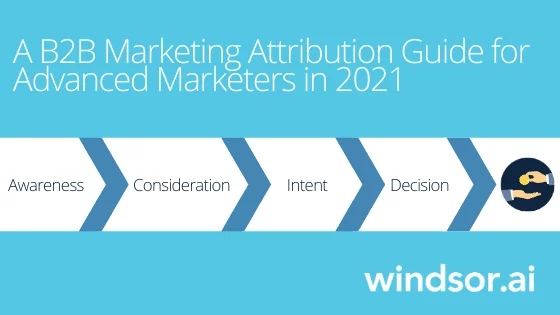
In this article, we’ll cover:
- An overview of what B2B marketing attribution is
- The biggest problems in B2B marketing attribution
- Recommendations on where and HOW to start with B2B marketing attribution
But let’s begin with some basics to stay on the same page later on.
What is B2B marketing attribution?
Generally, B2B marketing attribution is a set of rules to assign credits to marketing touchpoints according to their influence on a key metric. In layman’s terms: A framework giving marketing decision-makers an understanding of which of their activities got the customer closer to a purchase
A complex B2B journey looks like this:

A B2B customer journey involves multiple parts of an organization before a decision is made. The bigger the conversion (contract) value, the more complex the journey. Attribution helps to quantify the impact of each touchpoint.
Challenges of B2B Marketing Attribution
B2B marketing attribution involves multiple people. Multiple people have multiple devices. It is a complex task. Creating an attribution model for a B2C is a much easier task as in most cases it only involves one person.
The customer journey in the B2B space is long and non-linear. It’s hard to predict the interactions. It is even harder to measure the impact of those.
Organizational alignment
Leaving the technicalities aside, the biggest issue in most cases is the organizational alignment towards becoming data-driven. B2C organizations, especially eCommerce, have long been data-driven and they had the pressure to be data-driven because of the lower margin these companies operate in.
In B2B in comparison, sales teams were the rain-makers that bought in the revenue through their network. In recent history, this is dramatically changing as B2-B buyers are radically more empowered than ever. Harvard Business Review and CEB report:
65% of customers tell us that they spent as much time as they’d expected to need for the entire purchase just getting ready to speak with a sales rep.
Research is usually done online and it is your job as a marketer to understand what the prospective buyer is doing online.
Fragmented tracking and data silos
In B2B attribution the post online conversion, in other words, what is happening after a form fill is as important to understand as what happens online.
Often these journeys are not connected and aligned. If you are working in a larger organization chances are high that your data is siloed and has different owners. Here is an example of a typical setup we see a way too often:
![]()
This led to the following issues:
- Teams track their own KPIs, cannibalizing conversion numbers
- Conversions tracked are not realistic (do not include actual pipeline contribution and lead quality)
A big challenge is that teams track their own KPIs, this cannibalizes conversion numbers of other teams. What needs to be done is that the whole customer journey is connected and each team gets a part of the credit for the conversions. This needs top-level alignment in any organization trying to break down the data silos.
We often see that optimizations are done on website events that do reflect reality. Organizations should connect their CRM and post online conversion information to understand the impact of cancellations, returns, or unqualified leads on their campaigns.
Multiple people aka a buying center are involved at different stages of the customer journey
Try to remember some of your past purchases from a corporate account. How many of them did you buy with no other people involved?
I mean, sometimes even for small things you have to convince someone that you need it. The bigger your purchase is and the more it impacts others, the more people are involved in the decision-making process.
When I purchased a professional plan from Hubspot at my previous job, I had to talk to the marketing team, to the sales team, to the CEO. We needed to discuss the benefits and pitfalls, the technical support, and the resources needed to implement it.
So Max (the CEO) took the negotiations and eventually bought the product. He was the person holding sales calls and giving his credit card.
But that’s not he who initiated that process.
So multiple people came across the different stages of the journey. And if you do attribution for an individual, you’ll most likely optimize for Max, because he’s bringing revenue to your business.
Needless to say, the Hubspot purchase decision was not a real enterprise purchase. If my company would have been a larger organization, there would have been an even more complex purchasing process including complex due diligence.
Traditional sales methodologies here talk about the buying center and you’ll likely find the roles as shown in the graphic below.
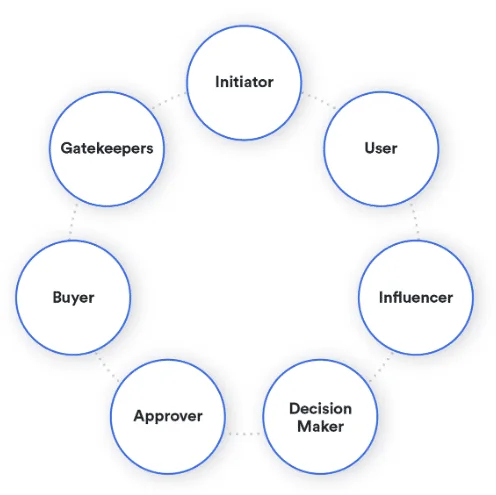
Applied on a customer journey that might look similar to this:

So in short: It’s much better to track the customer journey for the account instead, not an individual.
That’s a good moment to realize why Google Analytics is not good for most of the B2B cases.
But no panic! There is a way to solve that problem. I will share how to later on.
Complex lead nurturing where not everything is measured by revenue
I wish B2B marketing was as simple as forming a lookalike audience from your existing clients, putting out a Facebook ad, and waiting for revenue to flow. But even for a $5/mo B2B product, it still seems utopian to have such a process generating enough revenue.
It is hard to educate and convince your customers. It always takes time. It may take a month to make a decision to buy a $100/mo product. Not to speak of $100,000 checks.
So you most likely have a long journey with multiple touchpoints between your brand and a customer.
How do you measure the performance of those touchpoints?
If you measure revenue generated by a channel, it is a place to start. I cannot criticize you for that. Remembering the 80/20 book, it’s close to doing what it recommends. But if you’re big enough and a 1% improvement of the ROI equals a lot of money, it is probably time to look at the “80” part.
So what approach can you take instead?
Let’s break it down on real customer data examples.
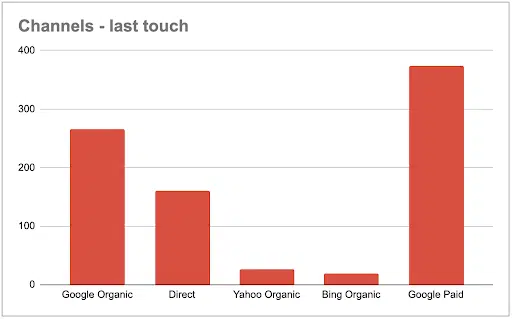
Let’s start with the most common attribution model – last touch. A default option for most of the analytics solutions and the one that usually defines what will get an investment and what will be shut down.
On this graph, you can see that Google paid campaigns are driving the most conversions and revenue for this business, with Google organic and direct traffic following them closely.
I believe this graph reflects how most the companies would allocate their budget.
But let’s look further.
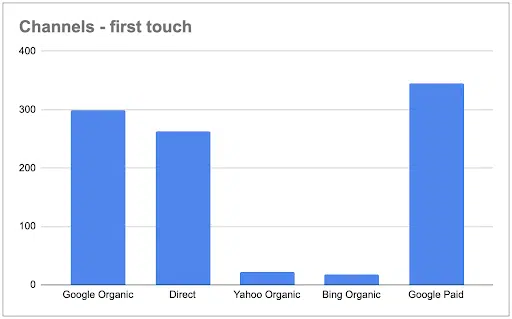
Here are the channels driving awareness. While Google ads are still leading, organic and direct became closer contenders here.
What’s interesting, is that Direct traffic became more significant with the first touch attribution model. Usually, it is vice-versa. It can say about strong brand awareness or trade shows, partnerships, etc. And this may help you to get the budget for those hardly measurable things.
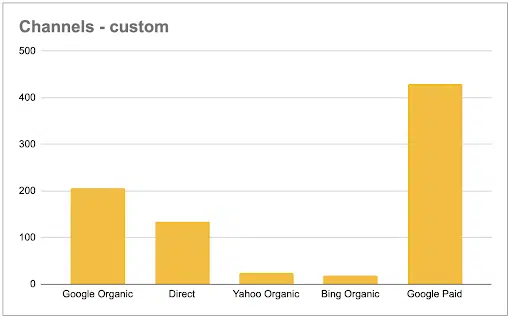
However, with a custom attribution model, the impact of Google paid traffic becomes undeniable.
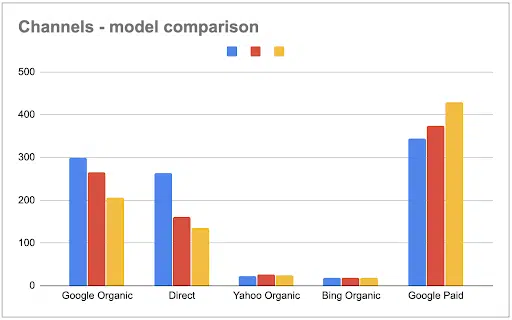
Here you can see the comparison of three attribution models. Comparing those gives a much stronger perspective on the performance of the channels and how you should allocate the budget.
But that’s not where the real magic happens.
While this data might be enough for a CMO to make a budgeting decision, there’s nothing a performance marketer can do with this graph.
If Google ads are that massive already, you most likely squeezed something from it with proper targeting, negative keywords, bid optimizations, etc.
That’s where attribution comes in.
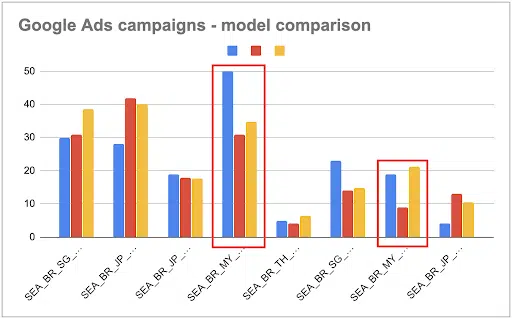
Here you can see the attribution model comparison on a campaign level.
It is quite clear with the campaigns #1 and #2. They are top performers for driving revenue.
Campaign number #4 is good at driving revenue as well, but it works exceptionally well for driving awareness. So putting more budget there might be a good idea if you want more people to come to your website.
But here’s the magic. That little highlighted campaign at the end of the graph. If you reallocate your ad budget between those campaigns according to the last-touch model, that one would probably be shut down. It has the second weakest performance according to the last-touch attribution model.
But in reality, that campaign is the fourth-best in driving revenue for your company. So maybe it deserves a chance?
But wait!
Nobody would blame you for shutting down these two, right?
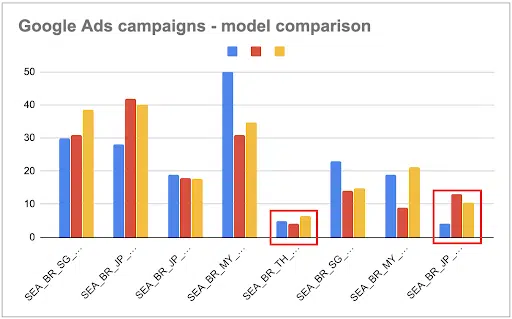
Let’s dig deeper.
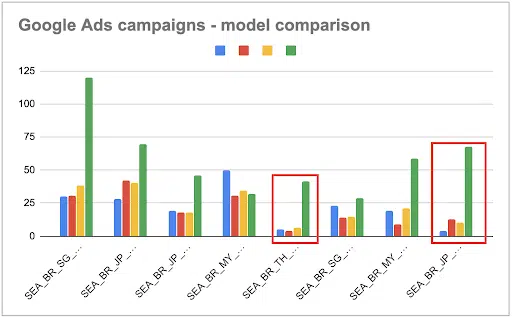
Here we have ROAS as a new green bar. And those two underdogs don’t look that bad now. While the campaign #4 is barely hitting the positive ROAS according to the custom model.
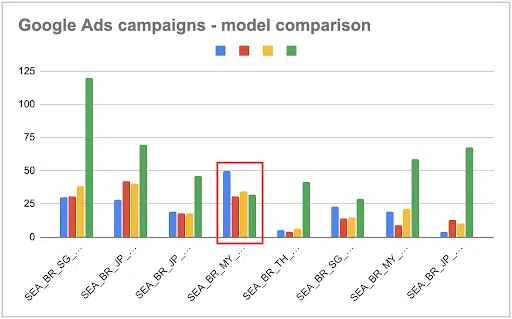
Would you ever think about shutting it down and reallocating the budget for campaigns #5 and #8 without seeing this chart?
By having this granularity, we can clearly see what is worth our attention and how to re-allocate the budget to have solid revenue streams and impressive ROAS.
Multiple target audiences and buyer personas
Our website is the biggest lead generation and conversion point for most of the cases. So we experiment with it sometimes (or always). We are all glad when our website conversion rate increases after a change. And we all get upset when it drops. But what we rarely do is asking “what for?”
It’s not a discovery to say that every business has multiple target audiences. If you have one, you just don’t know yet about others or don’t do segmenting well. But let’s drop it now and say you have multiple user cohorts coming to your website or whatever.
And when you go more precisely about any significant changes happening, like conversion rate drop, you should look at how it changed for those cohorts.
Let’s imagine you locally sell coffee machines in London. You started blogging some time ago on how to choose and maintain a coffee machine. To attract your target audience, you also started collaborating with local influencers and the best advertising agencies in London. And you encountered a problem with people outside the UK coming through your blog and calling you to buy a coffee machine.
It just drains your resources. So you added a big banner “LONDON ONLY” to your converting website pages.
If non-UK countries have a big part of your traffic, your conversion rate can drop dramatically. But for the London-based users, it may increase because of even higher relevance.
It would be great to have that cohort analysis holistically, isn’t it?
Here’s how we do it at Windsor.ai :
- A user lands on your website and gets a unique ID that is stored in a database.
- The anonymous user awaits further actions and identification like product signup or subscription.
- Additional parameters are added to a user record
- Behavioral or geodata extracted from cookies and CRM data.
- Advanced data from data enrichment tools like Clearbit, LeadGenius, etc.
- Users with certain parameters are pulled from the database into a report with an SQL request.
With this, you can evaluate your marketing performance for the user segments with the highest LTV and avoid optimizing for low LTV/high CAC users.
So these were the most common problems a B2B marketer can face with attribution modeling. I hope those are not obstacles anymore for you to make more data-driven decisions. But problems are not the starting point, so let’s break it down.
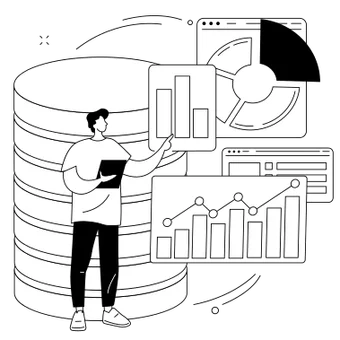
Try Windsor.ai today
Access all your data from your favorite sources in one place.
Get started for free with a 30 - day trial.
What you need to start with B2B attribution modeling
Here are the three important steps to start with B2B attribution modeling.
Start tagging every link that matters
Well, you might not track every single link in general, but there are parts of your funnel that are more important and more controllable than others.
Let’s break the funnel into such parts (image?)
- Acquisition
- Lead generation
- Lead nurturing
- Product usage
The funnel can be extended with Referrals or Product engagement tracking which is especially applicable for B2B SaaS to identify your power users and get viral exposure with a referral program.
Acquisition
Under “Acquisition” fall your activities towards getting an anonymous user to land on your website and/or provide information about them.
Organic search, paid search, paid social, and affiliate programs are some of the examples of acquisition channels.
Google made it harder for marketers to attribute conversions to certain keywords with organic traffic, so it’s a bit different story.
But with most other channels you have more control to set up parameters and track them later on.
UTM parameter consists of:
utm_source=Identify the source of traffic (Google, Facebook, newsletter)
utm_medium=Define the nature of traffic (CPC, sponsorship. etc.)
utm_campaign=Find a specific campaign (“us-retargeting”, “attribution-playbook”, etc.)
And for more in-depth tracking:
utm_term=To specify keywords for paid search campaigns (attribution+software)
utm_content=To differentiate A/B tests or specify content promotions.
More information and a template on how to structure UTM tags here https://windsor.ai/utm-tagging-fundamentals/. You can find Google’s campaign URL builder here https://ga-dev-tools.appspot.com/campaign-url-builder/ to easily build UTM-tagged links.
The example of the UTM-tagged link will look like this:
So start putting UTM parameters into links you share online. Even if you don’t do attribution modeling now, it will pay off by having historical data to optimize your marketing when the time comes.
Lead Generation
That moment when you receive permission to talk to a person directly. It can be a blog subscription form, guide download, demo request, or free tool signup. You name it.
It is an important step to track in a B2B space. So how do you make sure to match this submission to initial actions from the anonymous user? Let’s break it.
Important note: In most cases, people sign up for a form while browsing the website, but there are cases when you link to the form from an external source. In this case, you should UTM-tag the link as in the acquisition step.
To track how the user interacts with you pre and post a form fill here is a summary on the steps which need to be taken to match Google Analytics and CRM data:
- Create a unique identifier that is captured with every form submission
- Store the identifier in Google Analytics
- Store the same identifier in the CRM system (through a hidden field in the form)
- On form submit create a trigger that sends the identifier to the CRM
- Match both the IDs you have saved in Google Analytics and your CRM
Here is a detailed description including all the changes you need to make.
Lead nurturing
You have an email and identifier of your lead now. But that’s far from revenue yet. There is this chasm you need to cross called nurturing.
You can argue with that, but most of the nurturing process is taking place in a user’s email inbox.
You can show demos, schedule webinars, and share articles. But it all mostly happens via email. So you need to properly track what happens within your email, and if people take action from there.
The journey ID we have from the lead generation stage is now stored in your CRM system. Now every demo, in-person meeting and email you exchange with the lead or opportunity will be tracked inside your CRM. You can now understand the acquisition journey and combine it easily with the lead nurturing journey all the way towards deal closure.
Product usage
This stage begins from the moment a user has static credentials to log in – the registration. It might seem counter-intuitive to track every user login with identification and event tracking like in the lead conversion stage. But in reality, it is your opportunity to get all the missing pieces together. Here’s why.
Every customer had its own journey to becoming your customer. Redundant, I know. So this path might be taken from multiple devices and locations. They might see your article on mobile, browse the website from a home computer, and make a transaction from a laptop at work.
But remember that all of those interactions are in a database waiting for their time. By being patient, you give your customers an opportunity to log in from those other devices. And when they do, the missing data pieces combine into one user journey.
The mobile device, the home computer, and the work laptop are now having a strong identifier of login credentials to bridge the gap.
Get a strong alignment between the departments
Needless to say that everyone in the organization should follow the rules of tagging links and also using the same format to avoid polluting your data with junk no one can read. It’s a whole topic in itself on how to get buy-in from the stakeholders.
I’m definitely not the best person to cover it. But what I can surely say is a good starting point is explaining the benefits to each department in their own language.
For a sales department, it won’t make sense to “tag every link to have clean data” but it would make sense for them to help you bring their best leads who’re closing easily and have high checks.
So find that lever for your stakeholders and make some time for it.
13 Best Practices for Winning at B2B Multi-Touch Attribution Modelling
It is extremely tough to identify marketing channels where you can put more efforts for getting desired results and stop working on those channels that are killing your marketing budget.
But, with the help of attribution modeling, you can discover all those hidden marketing campaigns and touch-points that can effectively boost the revenue of the business.
Expert marketers realize the benefit of using multi-touch attribution modeling. They know that it is quite helpful for them to find ways to increase their customer engagement by tracking and measuring the performance of different touch points, which is almost impossible without using multi-touch attribution.
To get the maximum benefit from multi-touch attribution, here are 13 best practices for getting the best out of Multi-Touch Attribution Modelling.
1. Assign an Attribution Leader
Multi-touch attribution models give the advantage by showing detailed analysis of all the marketing channels.
This is very effective in designing or redesigning a marketing strategy that is geared at increasing revenue, getting more sales, and boosting marketing ROI of any business.
Assigning a specific person who is responsible for taking all those key decisions, can make the process organized because he/she can take all the decisions and prioritize actions based on the actual marketing performance data.
2. Provide Adequate Knowledge to Stakeholders
Educating your stakeholders on the multi-touch attribution is essential to make them realize its benefits.
These stakeholders can range from C-level Marketing & Management Executives to Middle Management.
The use of attribution modeling is still not fully adopted in most of the organizations, and they still rely on traditional and inaccurate ways of gauging marketing performance.
For example, a lot of marketers use the last click attribution model to analyze conversion statistics even though it provides a wrong assessment in most of the cases.
That’s why it is quite significant to brief them on the power of attribution modeling and how it can bring in the true performance of each marketing campaign and channel.
3. Utilize a Central Performance Tracking Solution
Normally, a specific budget is allocated to every marketing channel, and its performance is tracked using different metrics for each, which consumes a lot of time, and it is also not the most accurate way to track the results.
By using multi-touch attribution solution, this problem can be easily tackled because it allows marketers to keep an eye on all the marketing channels using a single platform.
Additionally, it aligns the team to work together by showing the performance of all the touch points in a central performance tracking platform instead of using different software for all.
4. Gather Entire statistics of Conversions and Ad Campaigns
Having complete data of conversions and ad campaigns is extremely important for B2B marketers to discover the information required to perform their jobs. It provides a clear overview of customers’ touch points across your ads and how they drive conversions.
The best way to track them is to integrate this data into your marketing attribution software.
By doing this, your entire team will get rid of multiple reports and silo systems. It also enables them to view all the critical marketing performance data within a single platform.
It will also ensure that you can assign a budget to those marketing channels or ad campaigns that play a major role in closing sales.
5. Link Your Touch Points with Buyers Journey
Attribution Modelling when done right, is capable of linking your touch points and mapping them with complete customer journey.
Attribution model can help you in ensuring that you allocate the right credit among the entire touch points of your customer’s journey.
This gives marketers the trusted data and insight which are necessary to understand the actual marketing performance and utilize the budget on revenue-generating touch points in a better and more informed way.
6. Utilize a Cohort Strategy to Define ROI
The capability of measuring the impact of every touch point on customer’s journey helps marketers to know about their marketing revenues accurately. This strategy is perfect for bigger B2B businesses where finding an accurate ROI is not less than a challenge.
It will provide them a clear picture of their ad campaigns like the starting day of their campaign, tracking the conversions, keeping an eye on the variety of traffic, identifying sources by channels, and analyzing the overall performance of their ads.
With this, they can easily allocate their assigned budget to get the maximum outcome from the campaigns and overall marketing efforts. It will also provide accurate insight regarding the best performing campaigns so that the marketers have the perfect control over the spending.
7. Combine Offline Attribution
Offline marketing channels have a major influence on many B2B businesses, and it should not be ignored. These marketing activities like field events, conferences, in-store sales, etc. are normally not considered in the finalization of the ROI.
This ignorance has a negative impact on budget allocation because you did not include the efforts of all the offline channels that have a specific role in the success of your business.
Sometimes, the users visit your website after attending any field event. The efforts of organizing and executing the field event to grab people’s attention make them the visitors of your website.
Considering this, if you ignore the offline channels, you cannot come up with a perfect strategy to calculate the accurate ROI of your marketing efforts for the business.
The best practice, in that case, is to merge your offline campaigns along with online channels with the help of a single multi-touch attribution. It will track the offline conversions automatically and equally allocate the ROI credit between the online and offline touch points.
8. Trace Account-Based Attribution for B2B
In B2B, it is quite complex to track the customer journey accurately because there are different entities involved in the think tank of these businesses, who give their opinions before finalizing a purchase.
They will surely get to your website using different ways including your marketing ads, emails, typing your URL, SERPs, etc. In that case, account-based multi-touch attribution is the key for you.
If you do not use the account-based multi-touch attribution, then it is most likely that you will count them as separate visitors who can lead you towards the wrong conclusion.
This attribution will make things clear for you. You will easily recognize the account-based customer journey and ensure that you are investing your marketing budget in the right places.
9. Ensure Everything is Included Accurately
It gets tough for B2B marketers to handle various marketing channels and massive marketing budgets at times. It is mainly because of the limited time and a large number of clients that they fail to utilize the marketing channels and budget effectively.
This additional pressure often results in making the marketer utilize the budget in the wrong touch points which increases the cost and gives less ROI. It can raise many questions on the credibility of the marketer.
To solve this, multi-touch attribution can play a positive role for the marketer as well as the business. It will help marketers to avoid assigning credit to the incorrect touch points and help them perform an in-depth audit by drilling down all the marketing channels.
10. Utilize metrics that track Results Instead of Channels
Companies that use only channel-specific KPIs such as open rate, clicks, impressions, and page views tend to remain locked in their silos. They allocate budget and optimize spend within those silos only.
With that strategy, it is very common to make the wrong decisions because you are looking at a single channel only, rather than having a holistic view.
Moving to multi-channel metrics such as brand engagement or sales to get a better look at the results can be challenging, but it is necessary. Measuring meaningful markers reveals information about where your customers and prospects are on their journey and reveal how each touch point contributes to a conversion.
The bottom line is that most companies are trying to learn whether their tactics support their strategy. If you’re among them, a multi-channel attribution practice can help you move towards a holistic measurement approach. You’ll be in good company.
11. Using Integration Feature for Gathering Entire Data
Data gathering is a major concern in B2B businesses because clients have their data on multiple data sources. It consumes a lot of time to get all the data from different sources.
With the help of multi-touch attribution, all these key data can be seen on a single platform because these attribution solutions can integrate a wide range of data sources with them.
12. Starting with a Single Channel
Marketers should start with a specific channel and then proceed further with other channels. It will give them enough time, and they can concentrate better to see which channel is most productive for them.
This step by step approach will enable them to test all the channels in detail and help them create a successful marketing campaign.
13. Get Ready To Adopt Changes
Right adjustments are necessary to make sure your business is going in a positive direction. Sometimes, it’s better to move on with other marketing channels than working on the same channels to find more opportunities.
Multi-touch attribution will ensure that the performances of all marketing channels are visible to you so that you can invest in a more effective marketing channel for your business.
These are the best practices for winning at B2B multi-touch attribution. They are not only effective to recognize the performance of your B2B business, but also important to make sure that you can get the best possible outcome of using multi-touch attribution.
Get an attribution software like Windsor.ai that solves your problems
There are quite a few attribution modeling providers that can solve your problems. Most of them are targeting big enterprises, which makes them ridiculously expensive.
Do your own reasoning, and choose what fits your needs best. You can start from an attribution modeling software list on Capterra https://www.capterra.com/marketing-attribution-software/
So look around, and don’t forget that you’re always welcome at Windsor.ai.

Try Windsor.ai today
Access all your data from your favorite sources in one place.
Get started for free with a 30 - day trial.


